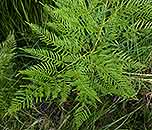Pteridium aquilinum (L.) Kuhn ssp. centrali-africanum Hieron. ex R.E.Fr.
Synonyms |
Pteridium centrali-africanum (Hieron.) Alston |
|---|---|
Common name |
|
Description |
Rhizome widely creeping, subterranean, 5-10 mm in diameter (up to 2.5 cm when fresh); rhizome scales brown, very fine, up to 1 mm long. Fronds widely spaced, stiff, hard, erect, pubescent fronds, 0.3-1.8(-3) m tall. Stipe up to 0.5 m long, underground portion swollen and covered with fine, brown hairs, above-ground portion pale-green, glabrous. Lamina 3-pinnate to 4-pinnatifid, triangular to oblong-ovate in outline. Pinnae ovate-triangular in outline, up to 40 x 15 cm, standing out from the rhachis horizontally at nearly right angles; basal pinnae as long as the lamina; pinnae in the upper half 2-pinnate. Pinnules deeply incised, joined to the costules, long caudate, lobes long caudate or linear, entire, lower surface with short hairs or subglabrous. Rhachis and secondary rhachises pale brown, eventually hairless. Sori linear, continuous, situated just inside the inrolled margins; pseudo-indusium continuous, membranous, c. 0.5 mm wide, ciliate. |
Notes | |
Derivation | aquilinum: of an eagle; either because the spreading pinnae resemble the wings of an aegle or a reference to the shape of the vascular bundle in the stipe. |
Habitat | Open Brachystegia woodland, along fringes of riverine vegetation, grassland, disturbed areas, weed in cultivation. |
Distribution worldwide | See African distribution. |
Distribution in Africa |
Angola, Burundi, Congo, Dem. Republic of Congo, Gabon, Malawi, Mozambique, Rwanda, Tanzania , Zambia, Zimbabwe. |
Growth form |
Terrestrial. |
Literature |
|

